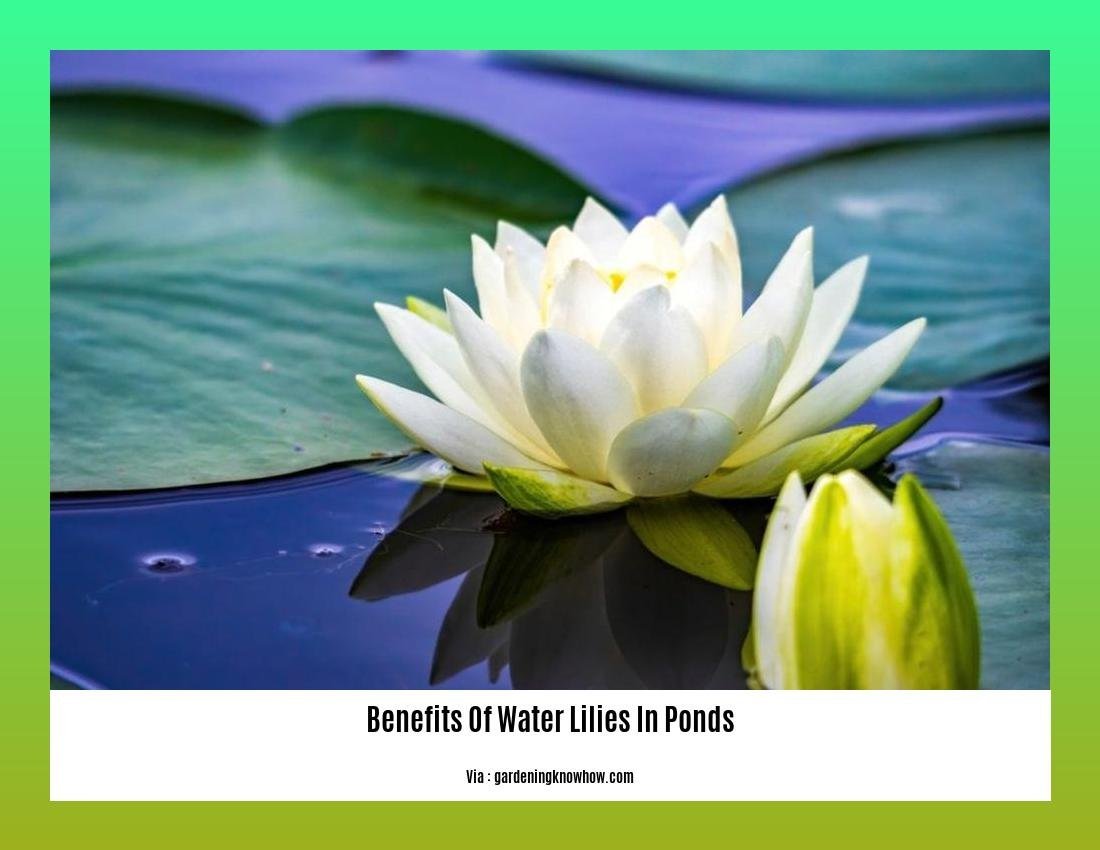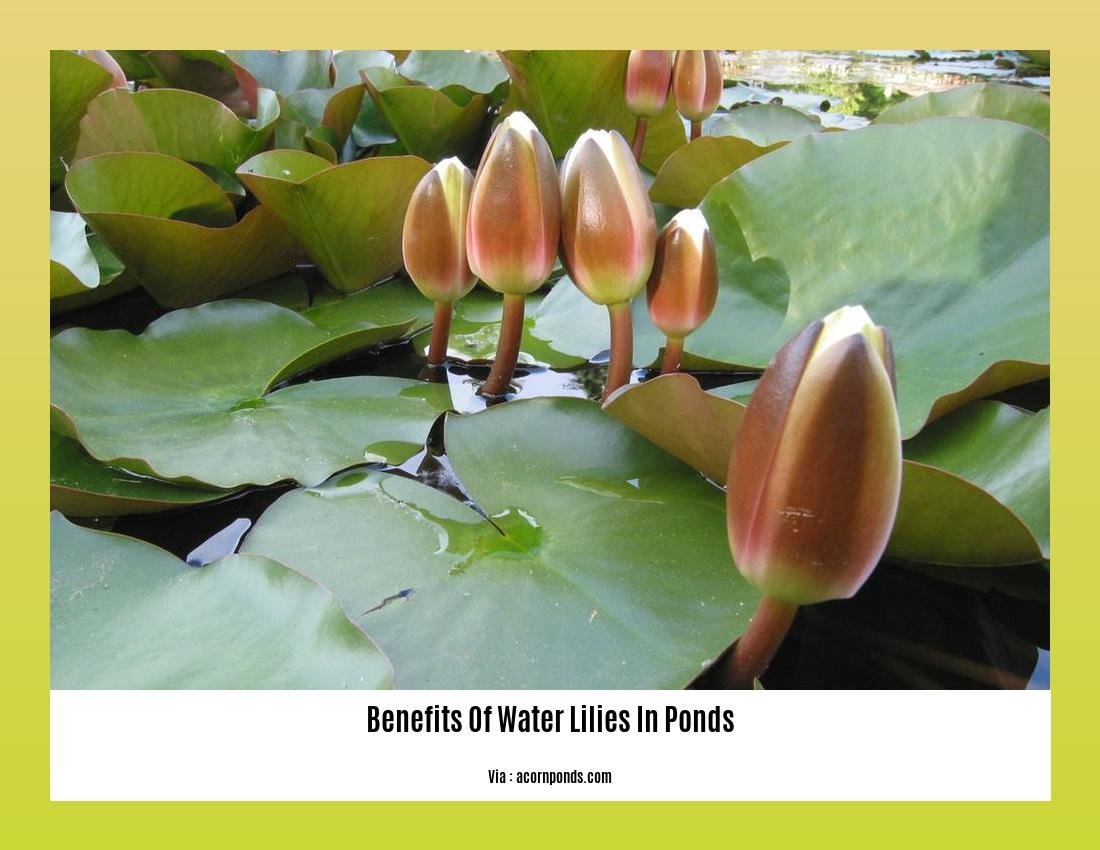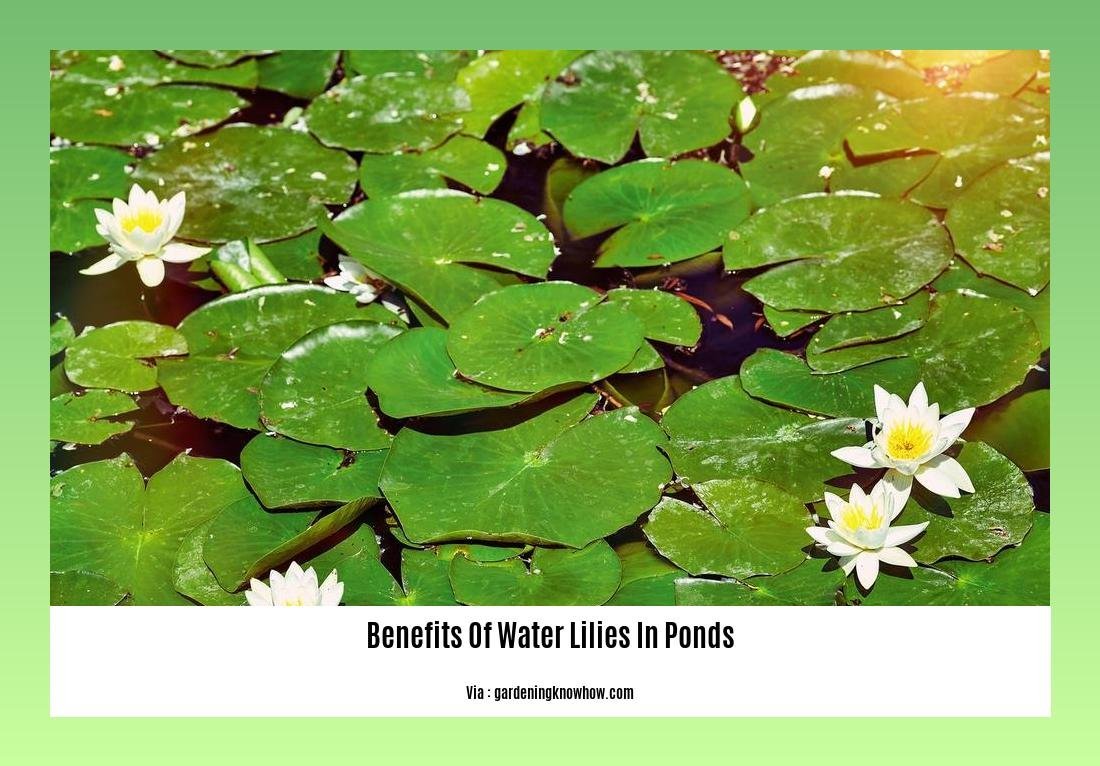Discover the essential benefits of water lilies in ponds and how these stunning aquatic plants can enhance ecosystems, improve water quality, and elevate the aesthetic appeal of your landscape. As highly experienced horticulturists, we understand the significant role that water lilies play in maintaining a balanced pond ecosystem. Through this article, we will delve into the myriad benefits these elegant plants offer, from their ability to filter water and provide shade to attracting beneficial wildlife. Join us as we explore the remarkable qualities of water lilies and learn how they can transform your pond into a thriving oasis.
Key Takeaways:
- Water lilies (scientific name Nymphaea) bring both aesthetic and functional benefits to ponds.
- Aesthetically, water lilies enhance the visual appeal of ponds with their vibrant colors and unique shapes.
- Water lilies play a crucial role in maintaining the ecological balance of ponds by providing shade that regulates water temperature and prevents excessive algae growth.
- The large lily pads of water lilies help cover the water surface, reducing sunlight penetration and inhibiting the growth of unwanted aquatic plants.
- Water lilies’ dense root system aids in water clarification by absorbing excess nutrients and filtering the water.
- Water lilies provide a safe haven and resting place for various aquatic animals, including frogs, turtles, and insects.
- The presence of water lilies in ponds creates a harmonious habitat, supporting overall ecosystem health and biodiversity.
Benefits of Water Lilies in Ponds

Water lilies, also known by their scientific name Nymphaea, are not just beautiful aquatic plants that grace the surface of ponds with their vibrant colors. They also bring a multitude of benefits to ponds, positively impacting both their aesthetics and functionality. In this article, we will explore the key benefits of water lilies in ponds.
Enhancing Aesthetics:
Water lilies are nature’s masterpieces, effortlessly enhancing the visual appeal of any pond. Their striking colors and unique shapes add a touch of natural beauty, turning an ordinary pond into a captivating aquatic haven. Imagine the serene tranquility of a pond adorned with the elegant blooms of water lilies, creating a picturesque landscape that soothes the soul.
Improving Water Quality:
Aside from their aesthetic value, water lilies play a significant role in maintaining the ecological balance of ponds. They serve as natural water regulators, benefiting both the plant life beneath the water’s surface and the overall health of the pond.
One key benefit is the shade provided by water lilies. Their floating leaves and exquisite flowers shield the water’s surface, sparing it from excessive sunlight exposure. This shade helps regulate the water temperature, preventing it from becoming too warm and creating an unfavorable environment for aquatic life. Additionally, the reduction in sunlight penetration minimizes the growth of unwanted algae, keeping the pond clear and maintaining its natural balance.
Furthermore, water lilies possess large lily pads that cover the water surface, acting as a natural barrier against the spread of invasive aquatic plants. By reducing sunlight penetration, they limit the resources available for the growth of undesirable plants, keeping the pond clear and inviting.
Water Clarification and Nutrient Absorption:
The dense root system of water lilies performs a vital function in water clarification. These roots absorb excess nutrients, such as nitrogen and phosphorus, which would otherwise contribute to algal blooms and poor water quality. By reducing the availability of these nutrients, water lilies help maintain the clarity and cleanliness of the pond, ensuring a healthy aquatic ecosystem.
Supporting Biodiversity:
Water lilies provide more than just a charming sight—they also offer a safe haven and resting place for various aquatic animals. Frogs, turtles, and insects find solace among the lily pads, using them as shelter and platforms for basking. This interconnectedness of plants and animals creates a harmonious habitat, supporting the overall health and biodiversity of the pond’s ecosystem.
Conclusion:
It is clear that water lilies are not only beautiful flowers but also vital contributors to the health and vitality of pond ecosystems. Their benefits span from enhancing the aesthetics of a pond to improving its water quality, supporting biodiversity, and maintaining an ecological balance. Water lilies truly are nature’s gift to ponds, enriching both the visual appeal and the well-being of these aquatic environments.
For more information on the benefits of water lilies in ponds, please refer to the following sources:
- The Benefits of Water Lilies in Ponds
- Water Lily Pond Benefits: Tips For Planting Water Lilies In Garden Ponds
Visiting the Kashi Vishwanath Temple is an experience like no other. Explore the numerous benefits of visiting this sacred place by clicking here.
Learn more about the importance of water conservation by visiting the Wikipedia page on the benefits of water conservation. Discover how small actions can make a big difference.
Bring tranquility and serenity into your home with a water fountain. Explore the incredible benefits of a water fountain at home and create your own oasis of relaxation.
Water Lilies: Nature’s Algae Controllers and Shade Providers for Ponds

Ponds: tranquil oases teeming with life. The role of water lilies in these aquatic ecosystems extends far beyond their mesmerizing beauty. These remarkable plants hold the power to provide shade and effectively control algae growth, contributing to the health and balance of the entire pond ecosystem.
Shade Provision: A Cool Oasis for Aquatic Life
Water lilies, with their expansive, flat leaves, create a serene canopy that blankets the pond’s surface and offers respite from the scorching sunlight. As sunlight filters through, the shimmering leaves act as a natural umbrella, reducing the direct sunlight that reaches the deeper parts of the pond. This protective shade maintains a stable and moderate temperature within the water, offering a cool haven for fish and other aquatic organisms.
Algae Control: A Natural Solution for Pristine Water Quality
The relentless growth of algae can swiftly disrupt the tranquility of a pond, affecting both its aesthetics and the well-being of its inhabitants. This is where water lilies come to the rescue. These elegant plants possess ingenious mechanisms that effectively control and restrict algae growth.
The broad leaves of water lilies exert their influence by minimizing sunlight penetration into the water, reducing the availability of light necessary for photosynthesis—a process vital for algae growth. By depriving algae of its life-sustaining sunlight, water lilies help maintain the pond’s pristine water quality.
But that’s not all! Water lilies are proficient nutrient managers. They possess a remarkable ability to uptake excessive nutrients like nitrogen and phosphorus—essential elements for algae growth. Through this process known as nutrient uptake or assimilation, water lilies serve as natural filters, effectively reducing the levels of these nutrients in the pond. This nutrient regulation results in improved water clarity and quality.
A Haven for Biodiversity
Water lilies don’t stop at controlling algae—they support and enhance biodiversity within the pond ecosystem. With their dense foliage and sprawling roots, water lilies provide shelter and hiding places for small aquatic organisms such as tadpoles, frogs, and insect larvae. These tiny inhabitants, in turn, play integral roles in the pond’s delicate food chain.
The allure of water lilies extends far beyond small creatures. Their presence also entices larger species, including birds, dragonflies, and fish, to join the vibrant tapestry of pond life. By acting as natural magnets for beneficial wildlife, water lilies enrich the biodiversity and foster the ecological balance within the pond.
Key Takeaways:
- Shade Provision: Water lilies create a cool oasis in ponds, sheltering aquatic life from the intense sunlight.
- Algae Control: Water lilies restrict algae growth by reducing sunlight penetration and absorbing excess nutrients, resulting in improved water quality and clarity.
- Biodiversity Enhancement: Water lilies provide shelter for small aquatic organisms, attracting larger species and enhancing the overall biodiversity of the pond.
Sources:
- Aquascape, Inc.
- DIY Garden Supplies
Water lilies attract and support beneficial wildlife.
Water lilies are not just beautiful flowers that grace the surface of ponds; they play a crucial role in attracting and supporting beneficial wildlife in these aquatic environments. Let’s explore the fascinating ways in which water lilies contribute to the health and sustainability of pond ecosystems.
Shade Provision for Pond Ecosystems
Water lilies are nature’s own umbrellas, providing a cool and shaded refuge for a variety of aquatic organisms. Their large, flat leaves spread across the water’s surface, creating a protective canopy that reduces direct sunlight penetration. This shade not only helps maintain a stable and comfortable temperature for fish and other aquatic animals but also prevents temperature fluctuations that can harm the delicate balance of the ecosystem.
Algae Control and Water Quality Improvement
One of the remarkable benefits of water lilies is their ability to control algae growth in ponds. Excessive algae can disrupt water clarity, deplete oxygen levels, and hinder the growth of beneficial aquatic plants. However, water lilies act as natural filters, combating these issues in multiple ways.
The broad leaves of water lilies create shade, limiting the amount of sunlight that reaches the water. By reducing sunlight penetration, water lilies inhibit the growth of algae, which typically thrives in well-lit environments.
Additionally, water lilies absorb excess nutrients like nitrogen and phosphorus, which are essential for algae growth. By assimilating these nutrients, water lilies help maintain balanced nutrient levels, improving water clarity and quality.
Biodiversity Enhancement
Water lilies form a crucial component of the intricate web of life within pond ecosystems. Their dense foliage and sprawling roots offer shelter, breeding grounds, and resting places for various aquatic organisms. Tadpoles, frogs, and insect larvae often find refuge among the lily pads, while larger species like birds, dragonflies, and fish are attracted by the abundance of prey. As a result, water lilies indirectly contribute to the overall biodiversity of the pond, promoting a healthy ecological balance.
Now that we’ve explored the significant role water lilies play in attracting and supporting beneficial wildlife, it’s clear that these enchanting aquatic plants are much more than just a decorative addition to ponds. They create shade, control algae growth, and provide a haven for a wide range of creatures, ensuring the overall health and vitality of the entire ecosystem.
Key Takeaways:
- Water lilies provide shade, creating a cooler and more stable environment for fish and aquatic organisms.
- These stunning plants naturally control algae growth by limiting sunlight penetration and absorbing excess nutrients.
- Water lilies attract and support a diverse range of wildlife, from smaller organisms like tadpoles and insects to larger species like birds and fish.
Sources:
- Aquascape, Inc. (2021, April 6). Water Lilies and Lotus.
- DIY Garden Supplies. (2020, October 29). How to Get Rid of Pond Algae and Keep It Away.
Water lilies add beauty and aesthetic appeal to ponds.
Water lilies – these captivating aquatic plants have a special place in our hearts, adding elegance and visual allure to ponds and water features. But their significance goes far beyond their beauty. Let’s delve into the wonders of water lilies, exploring how they enhance ecosystems, improve water quality, and bring aesthetic appeal to our ponds.
Shade Provision for Pond Ecosystems
Picture a picturesque pond basking in the warm sunlight. Water lilies gracefully float on the surface, their broad, vibrant leaves creating a stunning mosaic. But their luscious foliage serves a more vital purpose – providing shade for the inhabitants of the pond. The canopy of water lily leaves acts as nature’s parasol, shielding the water from direct sunlight. This sheltered environment not only creates a cooler haven for fish and other aquatic organisms but also minimizes temperature fluctuations that can disrupt the delicate balance of the ecosystem.
Controlling Algae Growth and Improving Water Quality
Ah, pesky algae – the bane of pond enthusiasts. Fear not, for water lilies come to the rescue! These marvelous plants possess natural powers that help curb the growth of algae, ensuring a healthy and clear pond. How do they achieve this feat? The broad leaves of water lilies limit sunlight penetration, reducing the availability of light vital for algae photosynthesis. Moreover, water lilies have a knack for absorbing excess nutrients like nitrogen and phosphorus, which are essential for algae growth. By assimilating these nutrients, water lilies play an integral role in maintaining water clarity and improving overall water quality.
Supporting Biodiversity in the Pond
Beyond their shade and algae-controlling prowess, water lilies foster biodiversity within the pond ecosystem. The dense foliage and intricate root system of these aquatic plants create an ideal habitat and hiding place for various aquatic organisms. Tiny tadpoles, frogs, and insect larvae find solace amongst the leaves and roots, thriving in the shelter provided by water lilies. This thriving microcosm of life, in turn, attracts larger species such as birds, dragonflies, and fish. With water lilies adorning your pond, you’re not just adding beauty – you’re encouraging a harmonious balance of life.
Key Takeaways:
- Water lilies create shade in ponds, providing a cool and stable environment for aquatic life.
- Their broad leaves limit sunlight penetration, restricting the growth of algae.
- Water lilies absorb excess nutrients, improving water quality and clarity.
- The dense foliage and roots of water lilies support biodiversity by providing shelter for various aquatic organisms.
- By fostering a balanced ecosystem, water lilies contribute to the health and vitality of the pond.
Sources:
1. Aquascape, Inc. (2021, April 6). Water Lilies and Lotus.
2. DIY Garden Supplies. (2020, October 29). How to Get Rid of Pond Algae and Keep It Away.
FAQ
Q1: What are the key benefits of having water lilies in ponds?
A1: Water lilies provide multiple benefits in ponds, including enhancing the aesthetic appeal, regulating water temperature, controlling algae growth, improving water quality, and supporting biodiversity.
Q2: How do water lilies contribute to maintaining the health of pond ecosystems?
A2: Water lilies play a crucial role in pond ecosystems by providing shade, which helps regulate water temperature and prevent excessive algae growth. They also absorb excess nutrients, filter the water, and create a safe habitat for various aquatic organisms.
Q3: Can water lilies help control algae growth in ponds?
A3: Yes, water lilies are effective in controlling algae growth in ponds. Their broad leaves reduce the availability of sunlight required for algae photosynthesis. Additionally, water lilies absorb excessive nutrients like nitrogen and phosphorus, which are essential for algae growth.
Q4: Do water lilies support biodiversity in ponds?
A4: Absolutely! Water lilies support biodiversity in ponds by providing shelter and hiding places for small aquatic organisms such as tadpoles, frogs, and insect larvae. These organisms, in turn, attract larger species, creating a balanced and diverse ecosystem.
Q5: How do water lilies contribute to improving water quality in ponds?
A5: Water lilies contribute to improving water quality in ponds by absorbing excess nutrients like nitrogen and phosphorus, which are often responsible for algae overgrowth. The filtering action of their dense root system helps clarify the water, resulting in better water clarity and overall improved water quality.
- Unveiling the Enigma: Mansoureh Khojasteh Bagherzadeh’s Public Appearances & Private Life in Iran - July 18, 2025
- Unveiling the Mystery: Mansoureh Khojasteh Bagherzadeh’s Husband: A Rare Glimpse into a Private Life - July 18, 2025
- Unveiling Masoud Khamenei’s Mother: Power, Influence, and Iran’s Future - July 18, 2025
















